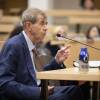In thinking about the last week's tragedy in Newtown, Connecticut, I keep coming upon the word epidemic. While the death of one child is too many, the death of nearly two dozen in one place, of hundreds in the span of a year — especially by violence, is intolerable. Or at least it should be.
And yet we do tolerate it. A report from the Children's Defense Fund found there were 173 firearm-related deaths of preschool aged children between 2008 and 2009. That was more than the number of law enforcement officers killed in the line of duty in the same period. And more than the number of military personnel who died serving in Iraq and Afghanistan that year.
Among the world's wealthiest countries, the U.S. accounts for 87 percent of all gun deaths of children under 15. And it might not shock you to find out, as I did from the online publication The Root, that African American children and teens represent only 15 percent of the U.S. children's population — yet are 45 percent of all gun-related deaths in this country.
So many have said in recent days that the country is suffering an epidemic of gun violence, which put me in the mind of another epidemic.
For decades this one ravaged this country, killing and maiming, with particularly tragic results for children. That epidemic had actually been around for hundreds of years. But at its height, in 1952, there were nearly 60,000 cases in this country, with more than 3,000 deaths.
It took decades to get the death rate down, although thousands of people continued to catch and suffer from the effects of this disease. Until finally, finally, this epidemic was virtually eliminated. Although every generation must still do its part to keep the scourge from coming back, it's now something most people read about in the history books.
What are we talking about? We're talking about polio. It touched and terrified people from all walks of life, including — later generations learned — President Franklin Delano Roosevelt. It cost him the use of his legs, although most people didn't know that at the time.
What brought an end to that epidemic was a combination of earlier diagnosis, better treatment, better sanitation, and yes, famously a vaccine which was perfected by Dr. Jonas Salk in 1952 and widely available by 1955.
Can I just ask you, what would it mean if we treated gun violence like polio? If we stopped arguing about who or what is at fault, and started treating it as the public health menace it is?
What would happen if started talking as much about the responsibility to keep each other safe as we do about the right to act as we please?
What would happen if we made teaching about appropriate ways to manage anger, depression and isolation as ubiquitous as the teaching about washing our hands with hot water and soap — and as available?
What might happen if we looked for a vaccine or other technological solutions to these violent outbursts? It sounds fanciful, but is that any more fanciful than injecting yourself with substance derived from the very thing that could kill you — which is what vaccines are?
What might happen if we climbed down from our respective platforms of self-righteousness and decided the most important thing is to save lives, without destroying other lives through incarceration policies that are already decimating the very communities we claim we want to save?
Finally what might happen if we agreed that any of us, or all of us, could be at risk? After all, gun violence has claimed the lives of four of our presidents. And in more than 20 attempts to kill a sitting or former president over the course of our history, overwhelmingly a gun was the weapon of choice.
Copyright 2016 NPR. To see more, visit http://www.npr.org/.



